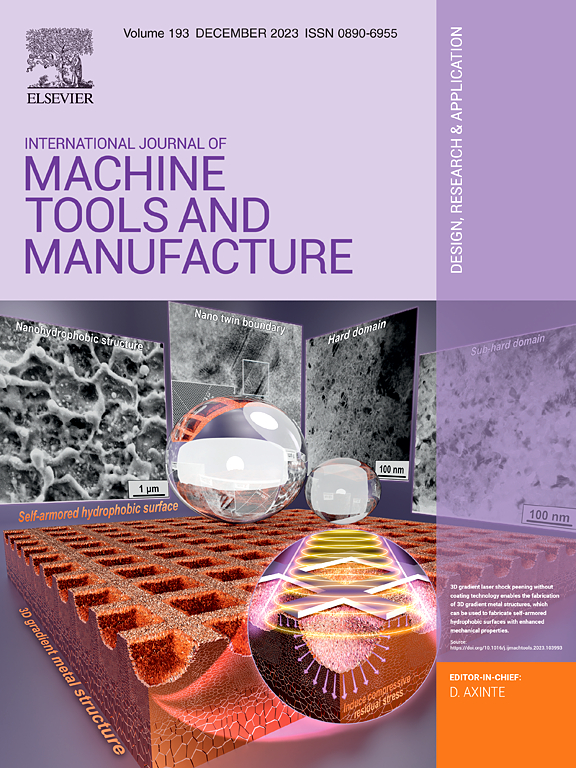一种提高增材制造合金表面均匀性的高效预溶电化学抛光方法
IF 18.8
1区 工程技术
Q1 ENGINEERING, MANUFACTURING
International Journal of Machine Tools & Manufacture
Pub Date : 2025-05-24
DOI:10.1016/j.ijmachtools.2025.104297
引用次数: 0
摘要
电化学抛光(ECP)在降低复杂增材制造(AMed)部件的表面粗糙度方面具有显著的优势。然而,传统的一步ECP方法阻碍了进一步去除近表面缺陷,如固有的粘合剂粉末和台阶效应,由于同时溶解和平滑过程。此外,形成的高阻氧化层与金属基体之间的拓扑一致性限制了抛光效果,产生不良的表面不一致和尺寸精度差。在本研究中,我们在常规ECP工艺之前引入了一个预溶步骤,即预溶ECP。该方法基于粘接粉末的电化学溶解行为和熔池(MP)结构,将不规则、粗糙的建成表面转化为电流密度分布均匀的预溶解MP形态,旨在优化后续的ECP工艺。通过现场x射线同步辐射观测与机械抛光前后样品的对比定量分析相结合,确定了精确的溶解参数,获得了高度差分布均匀的抛光表面。对于高Si含量的AMed铝合金,当预溶步骤中截面轮廓溶解区域百分比变化率为0.060±0.003% /min时,不同的粘接粉末区域在预溶表面呈现一致的高度差异。在随后的抛光步骤中,与直接ECP (~ 5.3 μm)相比,NaOH溶液中基于各向同性蚀刻的平滑效应进一步将预溶表面的表面粗糙度降低到~ 1.5 μm,相应的高度差标准差降低了80.7%。此外,使用低电压和一次性去除表面簇层可确保抛光后具有内部通道(Φ1.4 mm)的AMed热管的圆度公差(85.7%)和毛细作用(304.4%)得到改善。这种预溶解策略减轻了建成表面特征的复杂性和随机性,促进了更好的ECP性能。它还可以与先进的ECP技术集成,从而扩大AMed结构的应用潜力,包括但不限于内部通道。本文章由计算机程序翻译,如有差异,请以英文原文为准。

A high efficiency pre-dissolution electrochemical polishing method for improving surface uniformity in additively manufactured alloys
Electrochemical polishing (ECP) offers significant advantages in reducing surface roughness of complex additively manufactured (AMed) components. However, conventional one-step ECP methods hinder further removal of near-surface defects, such as inherent adhesive powders and step effects, owing to the simultaneous dissolution and smoothing processes. Additionally, the topological conformity between the formed high-resistance oxide layer and the metal matrix limits the polishing effectiveness, producing undesirable surface inconsistency and poor dimensional accuracy. In this study, we introduce a pre-dissolution step prior to the conventional ECP process, namely pre-dissolution ECP. This approach is based on the electrochemical dissolution behavior of adhesive powders and the melt pool (MP) structure to transform the irregular, rough as-built surface into a pre-dissolved MP morphology with a uniform current density distribution, aiming to optimize the subsequent ECP process. By combining in situ X-ray synchrotron radiation observation with comparative quantitative analysis of samples before and after mechanical polishing, precise dissolution parameters were determined to achieve a polished surface with uniformly distributed height differences. For AMed Al alloys with high Si content, when the percentage change rate of dissolved areas of the cross-sectional profile in the pre-dissolution step is 0.060 ± 0.003 %/min, different adhesive powder regions exhibit consistent height differences on the pre-dissolved surface. During the subsequent polishing step, compared to direct ECP (∼5.3 μm), the isotropic etching-based smoothing effect in NaOH solution further reduces surface roughness of the pre-dissolved surface to ∼1.5 μm, and the corresponding standard deviation of height difference is reduced by 80.7 %. Moreover, the use of low voltage and the one-time removal of surface cluster layers ensures improved roundness tolerance (85.7 %) and capillary action (304.4 %) for AMed heat pipes with internal channels (Φ1.4 mm) after polishing. This pre-dissolution strategy mitigates the complexity and randomness of as-built surface features, facilitating better ECP performance. It can also be integrated with advanced ECP technologies, thereby expanding the application potential of AMed structures, including but not limited to internal channels.
求助全文
通过发布文献求助,成功后即可免费获取论文全文。
去求助
来源期刊
CiteScore
25.70
自引率
10.00%
发文量
66
审稿时长
18 days
期刊介绍:
The International Journal of Machine Tools and Manufacture is dedicated to advancing scientific comprehension of the fundamental mechanics involved in processes and machines utilized in the manufacturing of engineering components. While the primary focus is on metals, the journal also explores applications in composites, ceramics, and other structural or functional materials. The coverage includes a diverse range of topics:
- Essential mechanics of processes involving material removal, accretion, and deformation, encompassing solid, semi-solid, or particulate forms.
- Significant scientific advancements in existing or new processes and machines.
- In-depth characterization of workpiece materials (structure/surfaces) through advanced techniques (e.g., SEM, EDS, TEM, EBSD, AES, Raman spectroscopy) to unveil new phenomenological aspects governing manufacturing processes.
- Tool design, utilization, and comprehensive studies of failure mechanisms.
- Innovative concepts of machine tools, fixtures, and tool holders supported by modeling and demonstrations relevant to manufacturing processes within the journal's scope.
- Novel scientific contributions exploring interactions between the machine tool, control system, software design, and processes.
- Studies elucidating specific mechanisms governing niche processes (e.g., ultra-high precision, nano/atomic level manufacturing with either mechanical or non-mechanical "tools").
- Innovative approaches, underpinned by thorough scientific analysis, addressing emerging or breakthrough processes (e.g., bio-inspired manufacturing) and/or applications (e.g., ultra-high precision optics).

 求助内容:
求助内容: 应助结果提醒方式:
应助结果提醒方式:


